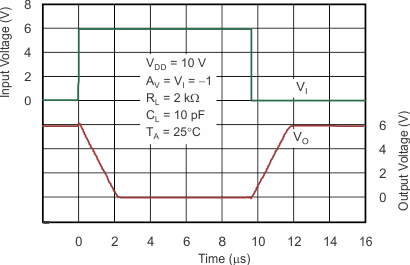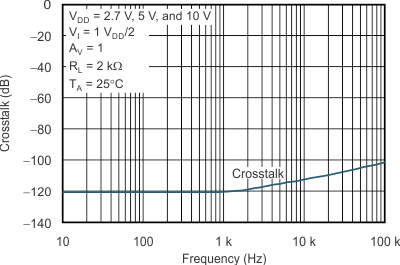SLOS351E February 2004 – November 2016 TLV271 , TLV272 , TLV274
PRODUCTION DATA.
- 1 Features
- 2 Applications
- 3 Description
- 4 Revision History
- 5 Device Comparison Table
- 6 Pin Configuration and Functions
-
7 Specifications
- 7.1 Absolute Maximum Ratings
- 7.2 Recommended Operating Conditions
- 7.3 Thermal Information: TLV271
- 7.4 Thermal Information: TLV272
- 7.5 Thermal Information: TLV274
- 7.6 Electrical Characteristics: DC Characteristics
- 7.7 Electrical Characteristics: Input Characteristics
- 7.8 Electrical Characteristics: Output Characteristics
- 7.9 Electrical Characteristics: Power Supply
- 7.10 Electrical Characteristics: Dynamic Performance
- 7.11 Electrical Characteristics: Noise/Distortion Performance
- 7.12 Typical Characteristics
- 8 Detailed Description
- 9 Application and Implementation
- 10Power Supply Recommendations
- 11Layout
- 12Device and Documentation Support
- 13Mechanical, Packaging, and Orderable Information
Package Options
Refer to the PDF data sheet for device specific package drawings
Mechanical Data (Package|Pins)
- D|8
- P|8
- DBV|5
Thermal pad, mechanical data (Package|Pins)
Orderable Information
7 Specifications
7.1 Absolute Maximum Ratings
over operating free-air temperature range (unless otherwise noted)(1)
(1) Stresses beyond those listed under Absolute Maximum Ratings may cause permanent damage to the device. These are stress ratings only, which do not imply functional operation of the device at these or any other conditions beyond those indicated under Recommended Operating Conditions. Exposure to absolute-maximum-rated conditions for extended periods may affect device reliability. All voltage values, except differential voltages, are with respect to GND.
7.2 Recommended Operating Conditions
over operating free-air temperature range (unless otherwise noted)| MIN | NOM | MAX | UNIT | ||
|---|---|---|---|---|---|
| Supply voltage, VDD | Single-supply | 2.7 | 16 | V | |
| Split-supply | ±1.35 | ±8 | |||
| Common-mode input voltage, VICR | 0 | VDD −1.35 | V | ||
| Operating free-air temperature, TA | C-suffix | 0 | 70 | °C | |
| I-suffix | –40 | 125 | |||
7.3 Thermal Information: TLV271
| THERMAL METRIC(1) | TLV271 | UNIT | |||
|---|---|---|---|---|---|
| D (SOIC) |
DBV (SOT-23) |
P (PDIP) |
|||
| 8 PINS | 5 PINS | 8 PINS | |||
| RθJA | Junction-to-ambient thermal resistance | 127.2 | 221.7 | 49.2 | °C/W |
| RθJC(top) | Junction-to-case (top) thermal resistance | 71.6 | 144.7 | 39.4 | °C/W |
| RθJB | Junction-to-board thermal resistance | 68.2 | 49.7 | 26.4 | °C/W |
| ψJT | Junction-to-top characterization parameter | 22 | 26.1 | 15.4 | °C/W |
| ψJB | Junction-to-board characterization parameter | 67.6 | 49 | 26.3 | °C/W |
| RθJC(bot) | Junction-to-case (bottom) thermal resistance | n/a | n/a | n/a | °C/W |
(1) For more information about traditional and new thermal metrics, see the Semiconductor and IC Package Thermal Metrics application report.
7.4 Thermal Information: TLV272
| THERMAL METRIC(1) | TLV272 | UNIT | |||
|---|---|---|---|---|---|
| D (SOIC) |
DGK (VSSOP) |
P (PDIP) |
|||
| 8 PINS | 8 PINS | 8 PINS | |||
| RθJA | Junction-to-ambient thermal resistance | 127.2 | 186.6 | 49.2 | °C/W |
| RθJC(top) | Junction-to-case (top) thermal resistance | 71.6 | 78.8 | 39.4 | °C/W |
| RθJB | Junction-to-board thermal resistance | 68.2 | 107.9 | 26.4 | °C/W |
| ψJT | Junction-to-top characterization parameter | 22 | 15.5 | 15.4 | °C/W |
| ψJB | Junction-to-board characterization parameter | 67.6 | 106.3 | 26.3 | °C/W |
| RθJC(bot) | Junction-to-case (bottom) thermal resistance | n/a | n/a | n/a | °C/W |
(1) For more information about traditional and new thermal metrics, see the Semiconductor and IC Package Thermal Metrics application report.
7.5 Thermal Information: TLV274
| THERMAL METRIC(1) | TLV274 | UNIT | |||
|---|---|---|---|---|---|
| D (SOIC) |
N (PDIP) |
PW (TSSOP) |
|||
| 14 PINS | 14 PINS | 14 PINS | |||
| RθJA | Junction-to-ambient thermal resistance | 97 | 66.3 | 135 | °C/W |
| RθJC(top) | Junction-to-case (top) thermal resistance | 56 | 20.5 | 45 | °C/W |
| RθJB | Junction-to-board thermal resistance | 53 | 26.8 | 66 | °C/W |
| ψJT | Junction-to-top characterization parameter | 19 | 2.1 | n/a | °C/W |
| ψJB | Junction-to-board characterization parameter | 46 | 26.2 | 60 | °C/W |
| RθJC(bot) | Junction-to-case (bottom) thermal resistance | n/a | n/a | n/a | °C/W |
(1) For more information about traditional and new thermal metrics, see the Semiconductor and IC Package Thermal Metrics application report.
7.6 Electrical Characteristics: DC Characteristics
at specified free-air temperature, VDD = 2.7 V, 5 V, and ±5 V (unless otherwise noted)| PARAMETER | TEST CONDITIONS | TA(1) | MIN | TYP | MAX | UNIT | ||
|---|---|---|---|---|---|---|---|---|
| VIO | Input offset voltage | VIC = VDD/2, RL = 10 kΩ, VO = VDD/2, RS = 50 Ω | 25°C | 0.5 | 5 | mV | ||
| Full range | 7 | |||||||
| αVIO | Offset voltage drift | 25°C | 2 | µV/°C | ||||
| CMRR | Common-mode rejection ratio | VIC = 0 to VDD − 1.35 V, RS = 50 Ω |
VDD = 2.7 V | 25°C | 58 | 70 | dB | |
| Full range | 55 | |||||||
| VIC = 0 to VDD − 1.35 V, RS = 50 Ω |
VDD = 5 V | 25°C | 65 | 80 | ||||
| Full range | 62 | |||||||
| VIC = –5 V to VDD − 1.35 V, RS = 50 Ω |
VDD = ±5 V | 25°C | 69 | 85 | ||||
| Full range | 66 | |||||||
| AVD | Large-signal differential voltage amplification | VO(PP) = VDD/2, RL = 10 kΩ |
VDD = 2.7 V | 25°C | 97 | 106 | dB | |
| Full range | 76 | |||||||
| VDD = 5 V | 25°C | 100 | 110 | |||||
| Full range | 86 | |||||||
| VDD = ±5 V | 25°C | 100 | 115 | |||||
| Full range | 90 | |||||||
(1) Full range is 0°C to 70°C for C-suffix and full range is –40°C to 125°C for I-suffix. If not specified, full range is –40°C to 125°C.
7.7 Electrical Characteristics: Input Characteristics
at specified free-air temperature, VDD = 2.7 V, 5 V, and ±5 V (unless otherwise noted).| PARAMETER | TEST CONDITIONS | TA | MIN | TYP | MAX | UNIT | |
|---|---|---|---|---|---|---|---|
| IIO | Input offset current | VDD = 5 V, VIC = VDD/2, VO = VDD/2, RS = 50 Ω |
25°C | 1 | 60 | pA | |
| 70°C | 100 | ||||||
| 125°C | 1000 | ||||||
| IIB | Input bias current | VDD = 5 V, VIC = VDD/2, VO = VDD/2, RS = 50 Ω |
25°C | 1 | 60 | pA | |
| 70°C | 100 | ||||||
| 125°C | 1000 | ||||||
| ri(d) | Differential input resistance | 25°C | 1000 | GΩ | |||
| CIC | Common-mode input capacitance | f = 21 kHz | 25°C | 8 | pF | ||
7.8 Electrical Characteristics: Output Characteristics
at specified free-air temperature, VDD = 2.7 V, 5 V, and ±5 V (unless otherwise noted).| PARAMETER | TEST CONDITIONS | TA | MIN | TYP | MAX | UNIT | ||
|---|---|---|---|---|---|---|---|---|
| VOH | High-level output voltage | VIC = VDD/2, IOH = –1 mA | VDD = 2.7 V | 25°C | 2.55 | 2.58 | V | |
| Full range | 2.48 | |||||||
| VDD = 5 V | 25°C | 4.9 | 4.93 | |||||
| Full range | 4.85 | |||||||
| VDD = ±5 V | 25°C | 4.92 | 4.96 | |||||
| Full range | 4.9 | |||||||
| VIC = VDD/2, IOH = –5 mA | VDD = 2.7 V | 25°C | 1.9 | 2.1 | ||||
| Full range | 1.5 | |||||||
| VDD = 5 V | 25°C | 4.6 | 4.68 | |||||
| Full range | 4.5 | |||||||
| VDD = ±5 V | 25°C | 4.7 | 4.84 | |||||
| Full range | 4.65 | |||||||
| VOL | Low-level output voltage | VIC = VDD/2, IOH = 1 mA | VDD = 2.7 V | 25°C | 0.1 | 0.15 | V | |
| Full range | 0.22 | |||||||
| VDD = 5 V | 25°C | 0.05 | 0.1 | |||||
| Full range | 0.15 | |||||||
| VDD = ±5 V | 25°C | –4.95 | –4.92 | |||||
| Full range | –4.9 | |||||||
| VIC = VDD/2, IOH = 5 mA | VDD = 2.7 V | 25°C | 0.5 | 0.7 | ||||
| Full range | 1.1 | |||||||
| VDD = 5 V | 25°C | 0.28 | 0.4 | |||||
| Full range | 0.5 | |||||||
| VDD = ±5 V | 25°C | –4.84 | –4.7 | |||||
| Full range | –4.65 | |||||||
| IO | Output current | VO = 0.5 V from rail, VDD = 2.7 V |
Positive rail | 25°C | 4 | mA | ||
| Negative rail | 25°C | 5 | ||||||
| VO = 0.5 V from rail, VDD = 5 V |
Positive rail | 25°C | 7 | |||||
| Negative rail | 25°C | 8 | ||||||
| VO = 0.5 V from rail, VDD = 10 V |
Positive rail | 25°C | 13 | |||||
| Negative rail | 25°C | 12 | ||||||
7.9 Electrical Characteristics: Power Supply
at specified free-air temperature, VDD = 2.7 V, 5 V, and ±5 V (unless otherwise noted).| PARAMETER | TEST CONDITIONS | TA(1) | MIN | TYP | MAX | UNIT | ||
|---|---|---|---|---|---|---|---|---|
| IDD | Supply current (per channel) |
VO = VDD/2 | VDD = 2.7 V | 25°C | 470 | 560 | µA | |
| VDD = 5 V | 25°C | 550 | 660 | |||||
| VDD = 10 V | 25°C | 625 | 800 | |||||
| Full range | 1000 | |||||||
| PSRR | Supply voltage rejection ratio (ΔVDD /ΔVIO) |
VDD = 2.7 V to 16 V, VIC = VDD/2, no load | 25°C | 70 | 80 | dB | ||
| Full range | 65 | |||||||
(1) Full range is 0°C to 70°C for C-suffix and full range is –40°C to 125°C for I-suffix. If not specified, full range is –40°C to 125°C.
7.10 Electrical Characteristics: Dynamic Performance
over operating free-air temperature range (unless otherwise noted).| PARAMETER | TEST CONDITIONS | TA(1) | MIN | TYP | MAX | UNIT | ||
|---|---|---|---|---|---|---|---|---|
| UGBW | Unity-gain bandwidth | RL = 2 kΩ, CL = 10 pF | VDD = 2.7 V | 25°C | 2.4 | MHz | ||
| VDD = 5 V to 10 V | 25°C | 3 | ||||||
| SR | Slew rate at unity gain | VO(PP) = VDD/2, CL = 50 pF, RL = 10 kΩ |
VDD = 2.7 V | 25°C | 1.35 | 2.1 | V/µs | |
| Full range | 1 | |||||||
| VDD = 5 V | 25°C | 1.45 | 2.4 | V/µs | ||||
| Full range | 1.2 | |||||||
| VDD = ±5 V | 25°C | 1.8 | 2.6 | V/µs | ||||
| Full range | 1.3 | |||||||
| φm | Phase margin | RL = 2 kΩ | CL = 10 pF | 25°C | 65 | ° | ||
| Gain margin | RL = 2 kΩ | CL = 10 pF | 25°C | 18 | dB | |||
| tS | Setting time | VDD = 2.7 V, V(STEP)PP = 1 V, AV = –1, CL = 10 pF RL = 2 kΩ |
0.1% | 25°C | 2.9 | µs | ||
| VDD = 5 V, ±5 V V(STEP)PP = 1 V, AV = –1, CL = 47 pF RL = 2 kΩ |
0.1% | 2 | ||||||
(1) Full range is 0°C to 70°C for C suffix and full range is –40°C to 125°C for I suffix. If not specified, full range is –40°C to 125°C.
7.11 Electrical Characteristics: Noise/Distortion Performance
over operating free-air temperature range (unless otherwise noted).| PARAMETER | TEST CONDITIONS | TA | MIN | TYP | MAX | UNIT | ||
|---|---|---|---|---|---|---|---|---|
| THD + N | Total harmonic distortion plus noise | VDD = 2.7 V, VO(PP) = VDD/2 V, RL = 2 kΩ , f = 10 kHz |
AV = 1 | 25°C | 0.02% | |||
| AV = 10 | 0.05% | |||||||
| AV = 100 | 0.18% | |||||||
| VDD = 5 V, ±5 V, VO(PP) = VDD/2 V, RL = 2 kΩ , f = 10 kHz |
AV = 1 | 25°C | 0.02% | |||||
| AV = 10 | 0.09% | |||||||
| AV = 100 | 0.5% | |||||||
| Vn | Equivalent input noise voltage | f = 1 kHz | 25°C | 39 | nV/√Hz | |||
| f = 10 kHz | 35 | |||||||
| In | Equivalent input noise current | f = 1 kHz | 25°C | 0.6 | fA /√Hz | |||
7.12 Typical Characteristics
Table 1. Table of Graphs
| DESCRIPTION | FIGURE NO. | |||
|---|---|---|---|---|
| CMRR | Common-mode rejection ratio | vs Frequency | Figure 1 | |
| Input bias and offset current | vs Free-air temperature | Figure 2 | ||
| VOL | Low-level output voltage | vs Low-level output current | Figure 3, Figure 5, Figure 7 | |
| VOH | High-level output voltage | vs High-level output current | Figure 4, Figure 6, Figure 8 | |
| VO(PP) | Peak-to-peak output voltage | vs Frequency | Figure 9 | |
| IDD | Supply current | vs Supply voltage | Figure 10 | |
| PSRR | Power-supply rejection ratio | vs Frequency | Figure 11 | |
| AVD | Differential voltage gain and phase | vs Frequency | Figure 12 | |
| Gain-bandwidth product | vs Free-air temperature | Figure 13 | ||
| SR | Slew rate | vs Supply voltage | Figure 14 | |
| vs Free-air temperature | Figure 15 | |||
| φm | Phase margin | vs Capacitive load | Figure 16 | |
| Vn | Equivalent input noise voltage | vs Frequency | Figure 17 | |
| Voltage-follower large-signal pulse response | Figure 18, Figure 19 | |||
| Voltage-follower small-signal pulse response | Figure 20 | |||
| Inverting large-signal response | Figure 21, Figure 22 | |||
| Inverting small-signal response | Figure 23 | |||
| Crosstalk | vs Frequency | Figure 24 | ||
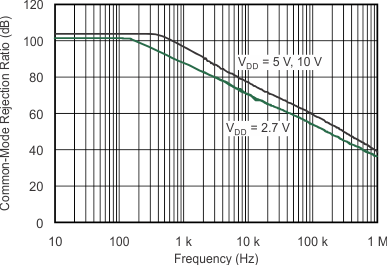
Frequency
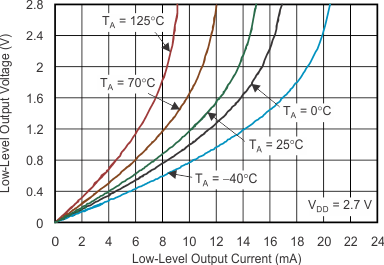
Low-Level Output Current
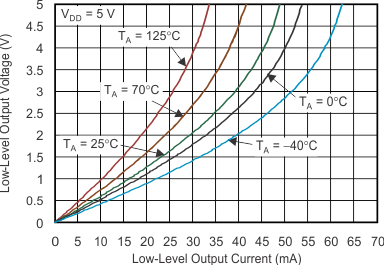
Low-Level Output Current
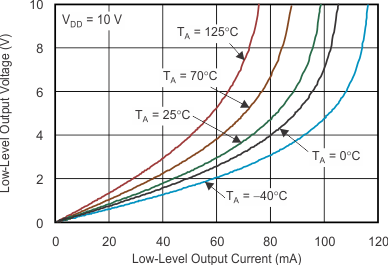
Low-Level Output Current
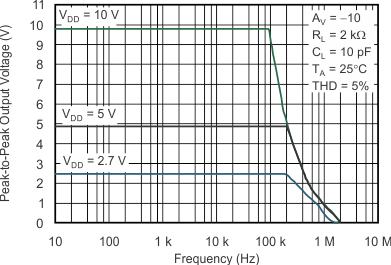
Frequency
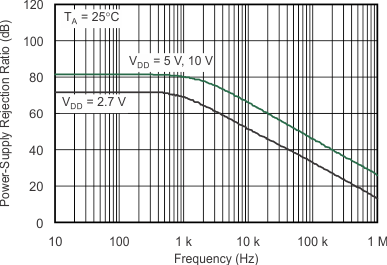
Frequency
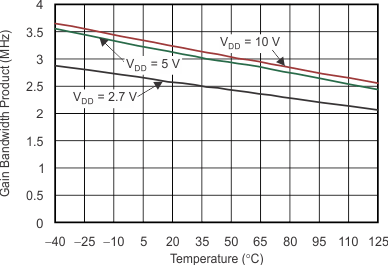
Free-Air Temperature
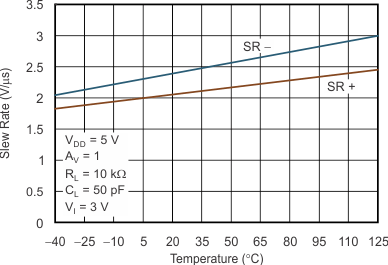
Free-Air Temperature
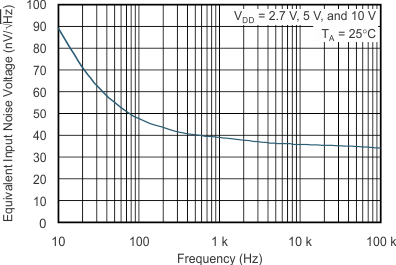
Frequency
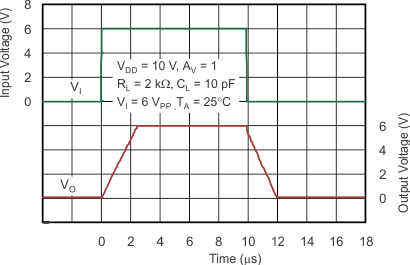
Pulse Response
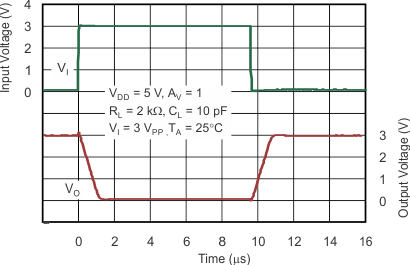
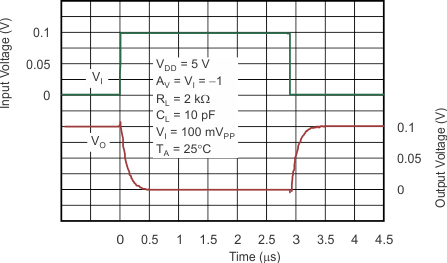
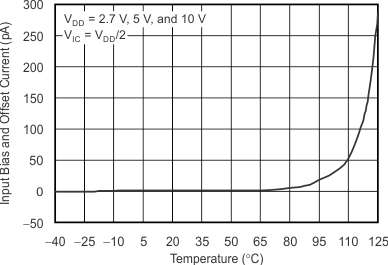
Free-Air Temperature
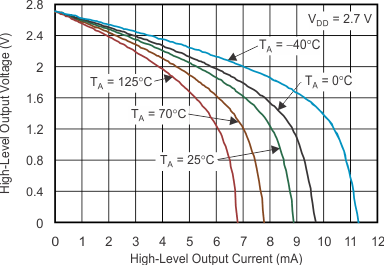
High-Level Output Current
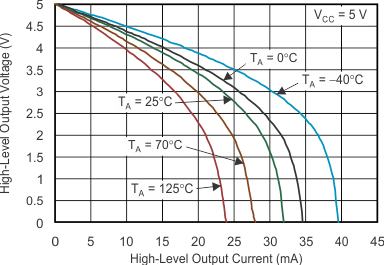
High-Level Output Current
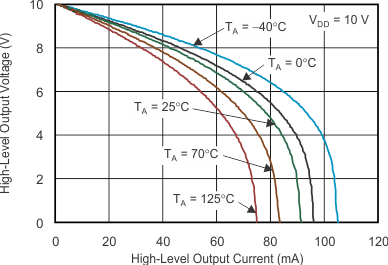
High-Level Output Current
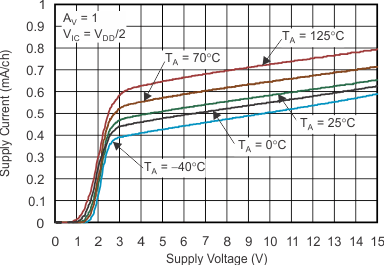
Supply Voltage
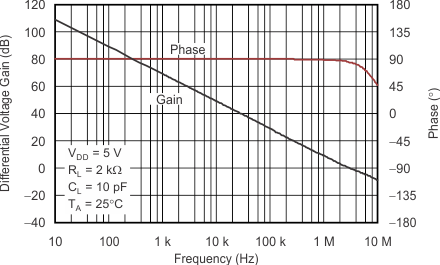
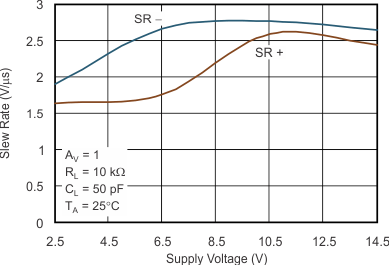
Supply Voltage
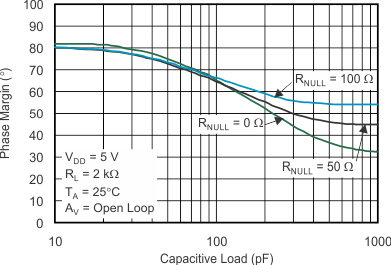
Capacitive Load
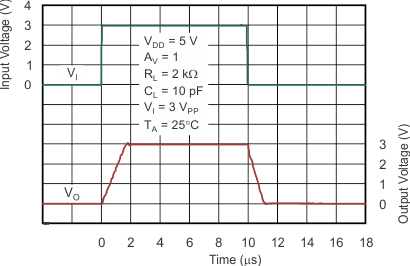
Pulse Response
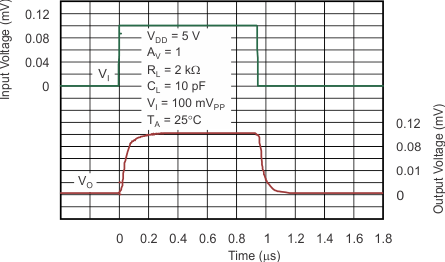
Pulse Response
